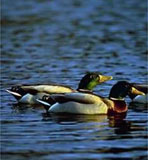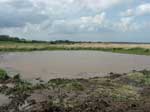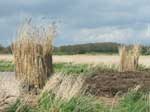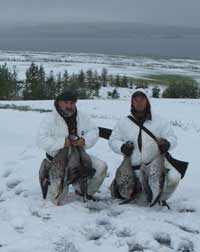|
Public access dissects reserve
The Association has lost its battle to prevent the public
using a path through the centre of our Halling reserve. Forty
years after the path was stopped up, a three day public enquiry
concluded that the claimed route has been dedicated as a public
footpath.
For the Association, Alan Jarrett, David Thorpe, Mark Robinson
and Pat Gough gave evidence that when we purchased the land,
the path was substantially overgrown and impassable, and had
long since been abandoned. However, several members of the
public claimed to have regularly walked the route during the
twenty year period before we brought the claimed route into
question, and the Inspector ruled in their favour.
A spokesperson for the reserve managers, Wild Spaces Fund,
said: “This is a devastating blow to our conservation
effort. The reserve is usually left quiet during the spring
and summer months but this path runs right through its heart
and will bring massive disturbance to nesting birds. It cuts
a 2 metre swathe through the otherwise impenetrable, dense,
thorny thickets, so important for nesting sparrows, finches,
long-tailed tits and song thrush. We are bitterly disappointed
with this decision.”
For the full Order Decision click
here
Wildfowler's dog mauled by
a seal.
Labrador Fly, had jumped into the North Sea near Newburgh
to retrieve a duck shot by owner Matthew Will, but the three-year-old
dog was mauled and dragged under the water by a seal over
twice his size.
There was
a sudden and terrific thrashing and howling in the water.
This huge seal, more than twice the size of the dog, was flinging
Fly around and pulling him under the water. Matthew, 21, of
Inverugie, Peterhead, ran into the water at the mouth of the
Tarty Burn to save the dog, but by the time he dragged the
animal to shore it was too late.
New shooting at Cliffe
The Kent Wildfowling and Conservation Association
(KWCA) has increased its land holdings still further by purchasing
30 acres of marshland at Cliffe on the southern side of the
River Thames in Kent.
KWCA Chairman Alan Jarrett commented, "We
have been able to continue our expansion with our third land
purchase in 2012. This latest purchase has taken us past £200,000
of spending for the year, and together with new rental agreements
adds over 600 acres in Kent and Essex to our land portfolio.
With high land prices and relative
scarcity of suitable land it is always pleasing to find a
piece of marsh that fits well with our strategic aims. The
land at Cliffe will offer us an opportunity to restore tile-drained
grazing land to the traditional marshland that it once was.
It will therefore fit well with our conservation agenda, whilst
providing valuable additional shooting opportunity for members.
Moreover it further cements our tenure in that part of the
North Kent Marshes, and reinforces our position as the largest
private landowner in North Kent."
Members - See
Latest News for details.
New shooting rights on the Ouse
Washes
In partnership with Ely & District
Wildfowlers Association we have secured shooting rights on
the Ouse Washes in Cambridgeshire. Full details of the location
and availability of the 50 acre wash are now available in
our Members' Section.
By working together with EDWA, one of the most proactive clubs
in that area, the KWCA are now able to offer shooting rights
for members for the first time on the Ouse Washes . This complements
our other shooting rights being assembled in Cambridgeshire
and Norfolk, and reinforces our programme of growth across
Eastern England.
New land at Hawkenbury
Full details of the 500 metres of
riverbank on the River Beult Hawkenbury, in the Weald of Kent
are now available in our Members' Section. Click on Hawkenbury.
BASC visit our Cooling Reserve
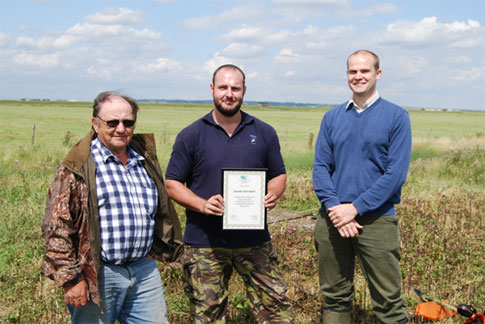
Bob Burgess - Westbere Reserve Manager,
Gareth Salvidant, Dan Reynolds - BASC SE Regional Director
Today during a visit to the Kent Wildfowling
and Conservation Association’s Cooling Reserve, Dan Reynolds,
the BASC South East Regional Director presented Gareth Salvidant
with a special award from the Wild Spaces Fund to recognise
his valued contribution to Conservation and Wildlife.
Gareth who is a mature student studying
Countryside Management at Aberystwyth University has just
completed a 14-month volunteer work placement with Wild Spaces
Fund the recently registered charity of KWCA. He has worked
on many varied projects including erecting fences, scrub clearance,
reedbed restoration to name just a few and worked at many
of the reserves under the stewardship of the Wild Spaces Fund.
His work has made a huge contribution to the capital works
program funded by Natural England under the KWCA Higher Level
Stewardship agreement.
Gareth commented, “that whilst he
would not necessarily want to pursue Wildfowling as a past
time, he now has an appreciation and respect for the commitment
that KWCA has towards its conservation responsibilities and
that this partnership demonstrates that Wildfowling and Conservation
go hand in hand”
Woodland shooting opens at Harris's
Copse - Wouldham/Blue Bell Hill
Following the KWCA's successful purchase
of 27 acres of woodland in the Medway area, the area is now
open for shooting and permits are available from 7 August.
This area offers rough shooting opportunities for club members.
Crucially the land will be available for shooting throughout
the year, thereby partly fulfilling the need for close season
shooting.
Members can see full details by clicking on Harris's
Copse.
KENT WILDFOWLERS
BUY MARSHLAND IN NORTH KENT
The Kent Wildfowling and Conservation Association (KWCA)
has increased its land holdings still further by purchasing
30 acres of marshland at Cliffe on the southern side of the
River Thames in Kent.
KWCA Chairman Alan Jarrett commented, "We have been
able to continue our expansion with our third land purchase
in 2012. This latest purchase has taken us past £200,000
of spending for the year, and together with new rental agreements
adds over 600 acres in Kent and Essex to our land portfolio.
With high land prices and relative scarcity of suitable land
it is always pleasing to find a piece of marsh that fits well
with our strategic aims. The land at Cliffe will offer us
an opportunity to restore tile-drained grazing land to the
traditional marshland that it once was. It will therefore
fit well with our conservation agenda, whilst providing valuable
additional shooting opportunity for members. Moreover it further
cements our tenure in that part of the North Kent Marshes,
and reinforces our position as the largest private landowner
in North Kent."
Members - See
Latest News for details.
NEW SHOOTING
ON THE OUSE WASHES
In partnership with Ely & District
Wildfowlers Association we have secured shooting rights on
the Ouse Washes in Cambridgeshire. Full details of the location
and availability of the 50 acre wash are now available in
our Members' Section.
By working together with EDWA, one of the most proactive clubs
in that area, the KWCA are now able to offer shooting rights
for members for the first time on the Ouse Washes . This complements
our other shooting rights being assembled in Cambridgeshire
and Norfolk, and reinforces our programme of growth across
Eastern England.
KENT WILDFOWLERS
BUY RIVER LAND IN WEALD OF KENT
The KWCA has been successful at auction in buying land adjacent
to the River Beult in the Weald of Kent. The land consists
of riverbank, pasture and woodland.
KWCA Chairman Alan Jarrett said, "This is a valuable
addition to our land holding. As well as providing additional
year-round rough shooting for members it also allows us to
increase the offer we can make to our growing fishing section.
Diversity is we believe a key to success for a large wildfowling
club in a modern world. Our offer now extends well beyond
foreshore wildfowling to encompass a wide variety of sporting
offers throughout Kent, and into East Sussex, Essex, Cambridgeshire
and Norfolk.
2012 is becoming another successful year for the KWCA with
several land acquisitions under our belt and more to follow."
KENT WILDFOWLERS
LAUNCH WILD SPACES FUND AS A CONSERVATION CHARITY
The Kent Wildfowling and Conservation Association (KWCA)
has made a major breakthrough for a wildfowling club by setting
up its own conservation arm, incorporating it as a limited
company and by achieving charitable status.
Wild Spaces Fund Ltd is now a registered charity, and will
be managing important conservation sites for the KWCA.
Wild Spaces Fund was set up in 2010, and already manages
six KWCA-owned sites across Kent. Work being carried out includes
the delivery of Higher Level Stewardship (HLS) targets which
have been agreed with Natural England.
Chairman Alan Jarrett commented, "This is a really important
step for the KWCA. We have an extensive conservation programme,
with several active HLS and ELS schemes. Wild Spaces Fund
is delivering important work on the ground across a number
of sites encompassing reed bed, brackish marshes and saltmarshes.
Becoming a registered charity will take us to a new level
in terms of our standing in the conservation world. There
are huge advantages to be gained, not least through enhanced
recognition and credibility. We have already managed to secure
additional funding for our work, and begun to tap into conservation
volunteers to assist in improving our sites.
We believe it to be a bold initiative that is going to yield
major dividends over time."
To make a donation or sign up as a Friend to the Wild Spaces
Fund go to www.wildspacesfund.org.uk.
ENDS
EDITOR'S NOTE: the KWCA has a land portfolio
of over 13,000 acres across Kent, East Sussex, Essex, Cambridgeshire
and Norfolk. Conservation work will be carried out over many
of these areas by the Wild Spaces Fund.
KENT WILDFOWLERS
PURCHASE LAND IN ESSEX
The KWCA has succeeded in purchasing 20 acres of saltmarshes
forming part of Baldwin's Farm, Barling Magna in Essex.
Club Chairman Alan Jarrett said "We have managed to
purchase these saltmarshes after lengthy negotiations, and
this allows us to permanently cement our presence in Essex.
The purchase represents another major step forward by the
KWCA and demonstrates how seriously we take our recent merger
with Leigh-on-Sea Wildfowlers.
It brings to a conclusion a successful year for the club
in which we have made land purchases in three different counties,
investing £250,000 in the process."
For further club details and a membership application form
contact the KWCA via www.kentwildfowlers.co.uk. Alternatively
telephone 07836771715
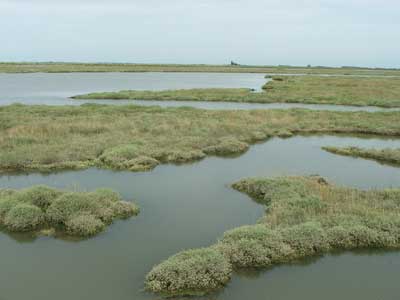
EDITOR'S NOTE: The KWCA is the largest
wildfowling association in Britain. It owns over 2,200 acres
of wetlands in Kent, East Sussex and Cambridgeshire and has
a total land portfolio of over 12,500 acres across Kent, East
Sussex, Essex, Cambridgeshire and Norfolk.
KENT WILDFOWLERS
EXTEND LAND HOLDINGS IN KENT
The KWCA has succeeded in acquiring 25 acres of marshes at
Teynham on the southern side The Swale. The land is a mixture
of lake, reedbeds and marsh, and further extends the club's
already substantial shooting rights.
Club Chairman Alan Jarrett said "We have managed to
acquire this new site for wildfowling, and it will no doubt
be a useful additional to the KWCA's land portfolio in Kent.
Recently acquisitions have been out of county, but we are
always on the lookout for suitable land in our own backyard.
The Teynham Marshes are traditional wet North Kent grazing
marshes, and to obtain a chunk of this is a real achievement
for the club.
We bought the land at public auction, and at £135,000
represents one of our largest cash purchases. The price of
available shooting land continues to escalate - simply because
they aren't making any more of it!
As regards future growth we are currently working with our
colleagues in the Leigh-on-Sea Wildfowlers to take on more
land outside of Kent."
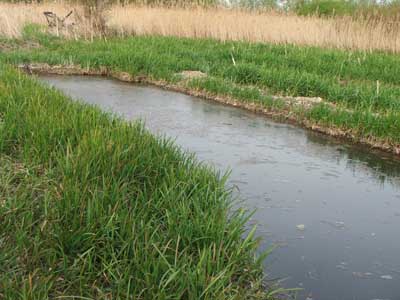
Members can click
here for further details.
KENT WILDFOWLERS
BUY NEW WILDFOWLING LAND
The KWCA has succeeded in the purchase of land on the Cam
Washes in Cambridgeshire close to the village of Upware. The
successful purchase was made via property auction and represents
the club's first land acquisition in Cambridgeshire. It further
increases the club's vast land portfolio.

Club Chairman Alan Jarrett commented "This is an important
purchase for us as we seek to expand our land holdings, and
provide more and diverse shooting opportunity for existing
and future members.
Every piece of land that is taken out of shooting can often
be lost forever, and our club is doing all it can to save
land for the sport. Although we have a limited budget, we
have been able to make a number of key acquisitions over the
last few years and it is work with which we shall continue
as funds allow.
The purchase is especially important in the context of our
recent merger with Leigh-On-Sea Wildfowlers, and demonstrates
that by working together wildfowlers can achieve so much more
than by working alone."
For further club details and a membership application form
contact the KWCA via www.kentwildfowlers.co.uk. Alternatively
telephone 07836771715
WILDFOWLING CLUBS
MERGE
In a ground-breaking agreement for wildfowling clubs on the
East Coast the Leigh-On-Sea Wildfowlers
Association (LOSWA) has merged with the Kent Wildfowling
and Conservation Association (KWCA). The combined membership
of the two clubs will exceed 500, which will strengthen the
position of both clubs, and in particular help to protect
wildfowling in Essex.
KWCA Chairman Alan Jarrett said: "This is an exciting
development for wildfowling in the south-east. By formally
amalgamating the two clubs will both become stronger, which
will help us to further expand our land portfolio - particularly
in South Essex where the sport in under such tremendous pressure.
I would particularly like to pay tribute to the officers,
committee and membership of LOSWA for having the foresight
and courage to merge with the KWCA, thereby maximising existing
and future opportunities for our sport.
We will now all work together towards our common goals, and
the sport of wildfowling will be the beneficiary."
LOSWA Chairman Ian Ross added: "After nearly 60 years
as a small independent club in South East Essex, it was becoming
increasingly difficult to find and maintain shooting in the
area.
The merger with the KWCA will provide all of our members
with a more secure shooting future and they will be in a better
position to take advantage of any new opportunities that arise."
For further details and a membership application form contact
the KWCA via www.kentwildfowlers.co.uk
KWCA continues with land acquisition
2010 was an impressive year for land acquisition by the Kent
club. Thornham Marshes, in North Norfolk has been the last
of 5 new areas of land for the club in the year.
In many ways the 564 acres of Thornham Marshes has been the
prize acquisition, allowing the KWCA to secure wildfowling
that was under threat of being lost to club shooting. The
land will be managed in a sensitive way, under consent from
Natural England, and will be available to club members on
a permit only basis.
Club Chairman Alan Jarrett said, "We have had another
highly successful year, with new land in the Medway Estuary,
The Swale, East Sussex, Essex and finally in North Norfolk.
These purchases have allowed us to substantially increase
our land portfolio by adding almost 800 acres of prime shooting
land. In particular the out of county land we have acquired
will allow us to increase our membership base.
We welcome membership applications from those wildfowlers
who want to enjoy our new land in Essex and North Norfolk,
as well of course those wanting to shoot in Kent and East
Sussex. Our strategy of proving more and diverse shooting
for the club is helping us to maintain membership at a high
level of almost 500, and this in turn will help to finance
the purchase of more land in the future."
For further details and a membership application form contact
the KWCA through www.kentwildfowlers.co.uk
New shooting grounds in Norfolk
KWCA
acquires shooting rights at Thornham
The Association
is delighted to announce that on 1st October we signed a 10-year
lease for the shooting rights over 564 acres of saltmarshes
at Thornham Marshes, on the North Norfolk coast.
This is a major acquisition for us, giving
access to some of the finest pinkfoot goose shooting in the
country, and will also allow our membership base to expand
in other counties.
At the moment we are waiting for consent
from Natural England, which has the potential to take some
time!
However, more news when we have it.
Conservation at Cooling Reserve
We have recently secured a Section 106 agreement (planning
gain) with Medway Council to provide compensatory habitat
for the new bridge being built at Stoke.
This conservation work was carried out on the seven acre
marsh at the southern end of our land at Cooling. Part of
the deal was to make this a non-shooting area.
This rejuvenation work, involving ditch reprofiling, scrape
creation, new gates and fencing has now been completed and
will soon provide a rich habitat for numerous wetland species.
New
shooting grounds in Essex
We have acquired
our first piece of land in Essex at Barling Magna north of
Great Wakering.
The
area consists of 20 acres of saltmarsh on Barling Creek, which
in turn flows into the River Roach.
Details of shooting dates and conditions appear in the August
Newsletter.
This acquisition represents a real breakthrough into a new
county and follows on from our successful expansion into East
Sussex. It services some of the needs of our growing membership
in South Essex.
New land purchase
|
The KWCA is delighted to announce the purchase of 140
acres of saltmarsh at Stoke Saltings.
The purchase allows us to secure the final part of
Stoke Saltings - land that has never been under the
control of the club, and increases our freehold land
ownership in the Medway Estuary still further to over
1,500 acres. It is our largest purchase in terms of
area since 1991.
Shooting details will appear in the August Newsletter.
|
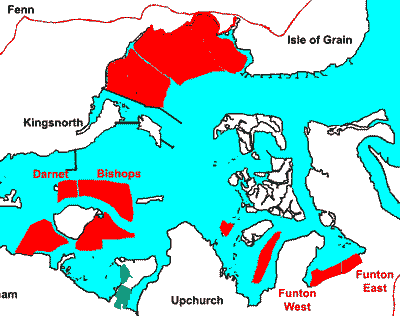 |
|
HLS work bears fruit at
Westbere
After years without management,
reedbeds naturally dry out as invasive willow and alder
slowly suck the lifeblood from a marsh. Dykes become
clogged and left to natures own devices, woodland would
prevail. Carefully applied actions such as reed cutting,
scrub and tree clearance, along with a program of ditch
work and water level control will, over time, reverse
the damage.
|
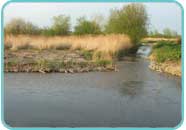 |
 |
As the reserve awakens from its long
winter slumber, heavy plant and chainsaws now away, we
can begin to see the fruits of the past months' labour.
Areas of reedbed, cut during the winter months, have begun
to show signs of Spring as new phragmites shoot, providing
ideal habitat for our increasing visible bittern population.
|
| Restoration of the southern ditch
is ongoing and the initial work looks very promising with
re-colonisation taking place at a rapid pace. Additional
culverts help to maintain good water quality, promoting
the fish and amphibian populations. The spoil will take
a little longer to settle and dry but when it does, it
should provide a raised footpath which, we hope, will
one day form part of a circular walk around the reserve. |
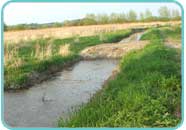 |
 |
The newly created pool may take longer
to colonise but the open water will be immediately attractive
to overwintering wildfowl as well as providing a haunt
for many of the hundreds of invertebrates, fish and amphibians
known to inhabit the reserve. |
New Shooting grounds
We have just acquired the shooting rights
over Fern Wood in Vinehall Forest at John's Cross. Fern Wood
is fairly small at 36 acres, but will provide valuable shooting
opportunity in a new area for us.
Additionally we have renewed the shooting rights at Beckley
Wood.
Permits are available for both of these areas throughout
the year.
More land at Motney Hill
The KWCA has purchased more land at Motney
Hill. It takes our land-holding there to 75 acres and means
that we will be in a position to further develop the conservation
potential of the site.
KWCA's latest Sporting Auction
Loads
of wildfowling related items were up for grabs.
Want us to send
you an email when it starts?
More Shooting Rights On
The Pevensey Levels
The club is pleased to comfirm the
acquisiton of an additional 110 acres of shooting rights on
the Pevensey Levels. The land is in three blocks near Newbridge,
which lies to the west of our existing land at Bowley's Marsh.
All three blocks have been acquired on a long-term lease,
and will be shot on a rotational basis with Bowley's marsh
making up a fourth area. This means that we will now have
shooting available on the Pevensey Levels every weekend throughout
the shooting season.
Full details will be available to club members in the August
newsletter.
|
Westbere Higher Level Stewardship Work
is well underway.
See the Wild
Spaces Fund website for details
|
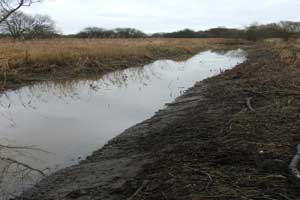 |
Members
- Fishing Section
The fishing section's lake on our Westbere Reserve is open
for use. Open to all Full and Associate Members for an extra
fee of £25.00 per year. Applications can be made to
the Membership Secretary, Bob Stead. Why not get this section
added to your membership when renewing your subs.
The 4-acre lake holds good bream and other coarse fish; whilst
the edges are somewhat overgrown, there are several accessible
swims. Restoration of the lake and clearance of swims is part
of the Higher Level Stewardship scheme entered into between
the KWCA and Nature England.
Not a Member? You will need to join
before you can fish this lake.
|
PURCHASE OF ADDITIONAL
LAND
We have managed to secure the
purchase of an additional 21.5 acres of land at Motney
Hill, Lower Rainham.
The land is upland to the west of the peninsula, and
will provide very limited shooting.
It is seen as an investment opportunity, mainly due
to the lack of land availability in the Medway Estuary.
|
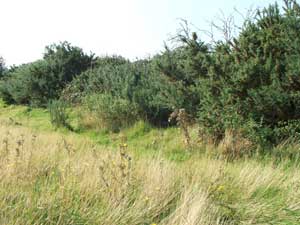 |
New
Shooting Grounds

The KWCA has acquired a long-term
lease over The Blackwall Land in East Sussex. The land consists
of 38 acres of prime marshland alongside Oxenbridge Marshes,
and will give us the opportunity to add considerably to the
size of the Oxenbridge permit area.
This will mean more permits at Oxenbridge, and therefore more
shooting opportunity in that area for members.
Once again the KWCA has worked in partnership with Chichester
Harbour Wildfowlers, who
contributed 50% of the purchase of this new area
Lucky Escape
The Medway Estuary escaped extensive flooding when a low-pressure
system in the North Sea caused a massive tidal surge to pour
into the river. Fortunately, the 2,5 metre surge peaked about
4 hours before high tide and rapidly ebbed before it became
a threat. High tide saw the surge only add an extra 0,9m to
the spring tide.
Members, see - tides - flood warnings to check for current
flood warning and see the real time state of the tide.
KWCA makes another important
Land Purchase
The Association has just acquired
48 acres of marshland on the Motney Hill peninsula.
Back in the 1970s, this area of reedbed,
favourite of bearded tits, buntings and warblers, was one of
the Kent Wildfowlers' first wildfowl reserves and we are delighted
to once again be in a position to manage the land.
Marshland shooting available
in Kent

Unique opportunity to shoot some
of North Kent's prime marshes with the Kent Wildfowlers.
Days available on Thames and Swale freshmarshes, guided by
experienced members of the Kent Wildfowlers.
£40.00 evening flight (all day shooting for that same
price may be available dependant on conditions and time of
year).
Apply in the first instance to the Club
Secretary
New Sporting Shooter website
launch.

The site launched on Monday. Take
a look, register, browse around, perhaps add something to
the forums and galleries. You can also listen (or even subscribe)
to the podcast!
CRoW invades the coast.
In February the NATURAL ENGLAND
BOARD issued their advice to Government on improving coastal
access in England.
Their proposals include legislation to create statutory powers
to align a coastal access corridor around the whole of the
undeveloped English coast, concentrating on filling existing
gaps in access.
The access corridor would include new areas of spreading room
along the coast and could formalise existing beach access,
complementary work to enhance coastal landscapes and the erection
of gates and bridges.
Natural England would undertake much of the planning and implementation
through access authorities and occupiers would enjoy the reduced
level of liability introduced for CRoW. How
does this affect us in Kent? Well, as far as our land goes,
improving access on salt marshes and mudflats raises health
and safety issues and would therefore be complicated, and
the practical public benefits limited, so this will not be
seen as a priority. It is likely that any new access in our
area will be limited to seawalls and as there are very few
gaps in the existing access, we will see little change.
Generally there are mixed feelings from
Wildfowlers; on the one hand, any increase in public disturbance
to our foreshore is unwelcome but on the other, improved access
for Wildfowlers could be of great benefit to some Clubs.
Click
here to read the full Paper.
"WILDFOWLING TALES"
brand new wildfowling book for 2007
Another spellbinding book by Alan
Jarrett with 50 brilliant wildfowling tales from the '70s
and '80s. Why wait until next season before the excitement
returns? Read this book and you will think that you are back
on the Marsh. Purchase direct
from the author at £18.00 + £2.00 postage and
packing.
Order
by email now.
Alan
Jarrett is elected onto the BASC
Council Results of
the 2012 Council election
There were five candidates standing
for three seats on BASC Council. The results of the Council
election are as follows, candidates are in the order in which
they appeared on the voting paper:
| Candidate |
Votes |
| Michael Hardy |
1382 |
| John Graham |
1100 |
| Martyn Parfitt |
1084 |
| John Thornley |
1600 |
| Alan Jarrett |
1377 |
John Thornley was elected to Council for
a second term.
Michael Hardy and Alan Jarrett were
elected to Council.
Alan
wishes to thank all who supported him.
KENT WILDFOWLERS LAUNCH WILD
SPACES FUND AS A CONSERVATION CHARITY
The Kent Wildfowling and Conservation Association
(KWCA) has made a major breakthrough for a wildfowling club
by setting up its own conservation arm, incorporating it as
a limited company and by achieving charitable status.
Wild Spaces Fund Ltd is now a registered
charity, and will be managing important conservation sites
for the KWCA.
Wild Spaces Fund was set up in 2010, and
already manages six KWCA-owned sites across Kent. Work being
carried out includes the delivery of Higher Level Stewardship
(HLS) targets which have been agreed with Natural England.
Chairman Alan Jarrett commented, "This
is a really important step for the KWCA. We have an extensive
conservation programme, with several active HLS and ELS schemes.
Wild Spaces Fund is delivering important work on the ground
across a number of sites encompassing reed bed, brackish marshes
and saltmarshes.
Becoming a registered charity will take
us to a new level in terms of our standing in the conservation
world. There are huge advantages to be gained, not least through
enhanced recognition and credibility. We have already managed
to secure additional funding for our work, and begun to tap
into conservation volunteers to assist in improving our sites.
We believe it to be a bold initiative that
is going to yield major dividends over time."
To make a donation or sign up as a Friend
to the Wild Spaces Fund go to www.wildspacesfund.org.uk.
EDITOR'S NOTE:
the KWCA has a land portfolio of over 13,000 acres across
Kent, East Sussex, Essex, Cambridgeshire and Norfolk. Conservation
work will be carried out over many of these areas by the Wild
Spaces Fund.
LOSWA
secures 600 acres at Chelmsford.
Thanks to excellent work by our new friends
at Leigh-on-Sea,
shooting rights are secured over 600 areas of farmland in
Essex. Members can find details in their latest newsletter
or online in the Members'
Section.
John Hoad
It is with a great sadness
that, after a long battle against cancer, we have to announce
the passing away of John Hoad.
John was a long standing member joining
the Kent Wildfowlers in the 50's and serving on the Association's
committee throughout the 60's and 70's. He was a particularly
active member always willing to help out with the clay shoots,
duck and gosling rearing schemes and the early dog trials.
John and his terriers were in great demand
on everyone's fox shoot; most shoots organising their entire
calendar around him. Many will remember his wildfowling punts;
seeing most of us floating around in makeshift plywood 'coffins'
prompted John to design and manufacture a very sound fibreglass
version. We believe they were the only duck punt to be mass
produced; many are still serviceable and in use to this day.
He eventually stopped wildfowling due to
old age but continued to work his beloved spaniels on various
shoots, and even after his cancer treatment, continued to
shoot clays, still hitting more than most of us.
Laidback and never harried, he introduced
many a youngster to wildfowling, full of encouragement and
willing to pass on his vast experience. He will be sadly missed.
Stoke Seawall Litter Clean
Up
A big thank you to
all who attended Saturday's clean up.
Attended by
new and old members alike; Saturday's seawall clean up proved
to be a great success. In all, we picked up 37 sacks of litter
ranging from lifebuoys to old boots. Some who could not attend
on the day had already made an effort during the week, making
our task that much easier.
An abundance
of Canada Geese, Greylag, Mallard and Tufted ducks, somehow
knowing that we were no longer a threat, performed several
low level passes making the morning even more enjoyable. One
real treat was finding fresh evidence of water voles along
what is probably the most brackish section of the delph ditch.
Well
done everyone!
New
Shooting Grounds

The KWCA has
acquired a long-term lease over The Blackwall Land in East
Sussex. The land consists of 38 acres of prime marshland alongside
Oxenbridge Marshes, and will give us the opportunity to add
considerably to the size of the Oxenbridge permit area.
This will mean more permits at Oxenbridge, and therefore more
shooting opportunity in that area for members.
Once again the KWCA has worked in partnership with Chichester
Harbour Wildfowlers, who contributed 50% of the purchase
of this new area.
Wildfowlers branch out!
We are delighted to announce that
two new areas of land, consisting of extensive blocks of woodland
totalling almost 600 acres, will be available for shooting
by day permit from 2nd February 2008.
Members - see latest news for details.
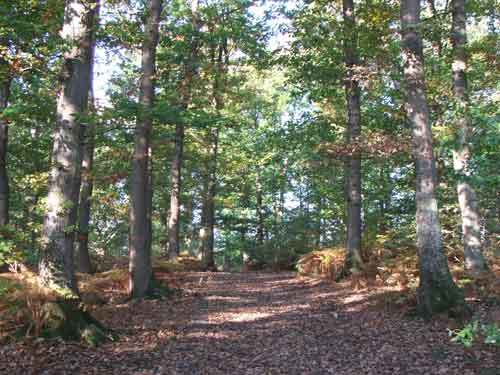
Do you want to shoot in these woods?
Join up now for the 2008 - 2009
season; shoot these woods, miles of foreshore and thousands
of acres of marshes.
Don't miss out on some of the best wildfowing in England!
Send
off for your application form now!
KWCA
cancels Gundog Working Tests
As a precautionary measure, after
tests confirmed a second outbreak of foot-and-mouth in Surrey,
the KWCA has postponed its 2007 gundog working tests until
further notice.
BASC statement on H5N1 outbreak
in Suffolk
The first case of H5N1 bird flu in British poultry for 15
years has been discovered on a turkey farm in Suffolk.
Nearly 160,000 turkeys are being gassed to contain the outbreak
at the Bernard Matthews site near Lowestoft.
Restriction zones have been set up around the farm and poultry
owners in the restricted area have been told to keep their
flocks isolated from wild birds. A three-kilometre Protection
Zone and a 10km Surveillance Zone also remain in place around
the farm site.
A much wider Restricted Zone covering 2,090 sq km is bordered
by the A140 to the west and the A47 to the north and almost
to Felixstowe in the south.
All bird gatherings - including shows, markets and fairs,
and pigeon races - have been banned nationwide until further
notice.
If you need advice on Avian flu please call the Defra Helpline
- 08459 33 55 77 (8.30am - 8.00pm 7 days a week) - and choose
the Avian Influenza option.
If you find dead gulls, waders, ducks, geese or swans and
you are within a surveillance area or are unsure whether you
are in a surveillance area (targeted surveillance for avian
influenza viruses in wild birds is ongoing) you may wish to
contact the Defra Helpline (as above) and choose the Avian
Influenza option.
How will this outbreak affect people
who shoot within the restricted zones?
As the outbreak is in a commercial flock, there are currently
no legal requirements to stop shooting activities in any of
the restricted zones. This situation is currently under review
and may change over the next few days. BASC is in constant
contact with Defra and will continue to monitor this situation.
Is it still safe to eat poultry?
The advice from the Food Standards Agency remains that properly
cooked poultry products including eggs are safe to eat.
What about wildfowlers?
Wildfowlers and those in contact with wild birds should take
appropriate hygiene precautions when handling wild birds.
Vigorous hand washing should take place after each activity.
What are the key biosecurity measures
people should be putting in place?
Don’t bring infection onto your farm or shoot, or spread
it around on your clothes, footwear or hands. Clean overalls
and footwear should be worn when entering shedding or pens
where birds are kept. Protective clothing and footwear should
be removed and either cleansed and disinfected, laundered
or disposed of after use.
Strictly limit and control access to places where birds are
kept. If possible the site should be fenced with a controlled
entry point. Visitors and their vehicles should be limited
and as far as possible kept away from the buildings and area
used by your birds.
Have pressure washers, brushes, hoses, water and an approved
disinfectant such as Virkon available. Make sure they are
used by visitors to clean vehicles, equipment and boots both
before entry and on leaving.
Clean and disinfect all vehicles after each journey. If possible,
do not use the same vehicles for transporting birds, feed,
manure or other wastes. Look out for signs of disease in your
flock. Increased mortality, falling egg production and respiratory
distress may be early signs of a disease problem.
Damaged eggs, dead birds, litter and manure may carry disease.
Dispose of them promptly and properly.
All the latest information about avian flu can be found on
the BASC website but for further advice and information members
can call the BASC avian flu hotline
on 01244 573056.
Bar-headed Goose at Oare Marshes
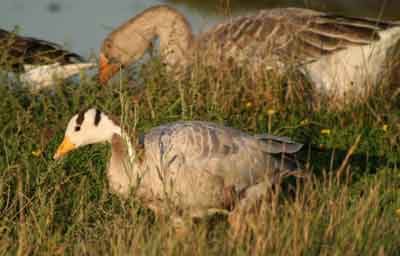
The Bar-head
Goose (Anser indicus) that has spent the summer at the Kent
Trust’s nature reserve at Oare, photographed amongst
Greylags by a KWCA Marsh Warden early this month.
An increasing common site in the British Isles (mainly due
to escapees), this pale grey Asian goose with a wing span
of approximately 150cm hatches its young on Lake Tsomoriri,
high in the Rupshu plains of the Tibetan plateau and on west
China's Qinghai lake. At the end of autumn they migrate to
the plains of northwest India by flying over the Himalayan
Mountains at altitudes of 30,000 feet.
One outbreak of avian influenza at Qinghai Lake last year
may have killed 10% of the world's Bar-headed Goose population!
Oxenbridge
Marshes Joint Venture
Over the last Bank Holiday volunteers from the Kent Wildfowling
& Conservation Association and the Chichester
Harbour Wildfowlers Association worked together on their
jointly owned conservation site at Oxenbridge. This important
wetland site on the East Sussex border between Wittersham
and Peasmarsh in the Rother Levels flood plain has enormous
potential and is home to many wildfowl species.
For three
days, the volunteers, with the aid of a digger, cleared two
of the main drainage ditches which, over the years, had become
choked with weed. They built a number of raised blinds and
dug out no less than eight wildfowl and wader scrapes. Despite
the current 'drought', water levels on the marsh remain high
and prospects for the coming season are looking very good.
A brand new
book by ALAN JARRETT out now.
Buy "Wildfowling - North and South" direct from
the author.
Including Alan's 'South African adventure' - Purchase direct
from the author at £18.00 + £2.00 postage and
packing.
Order
by email now.
This wonderful
176 page bargain contains beautifully descriptive tales of
Alan's wildfowling and shooting exploits in the UK, Canada,
Iceland and South Africa as well as excellent chapters on
fishing and conservation.
Read 'A
Hole in the Ground' an extract from Wildfowling - North and
South in Wildfowling>>in Kent>>adventures>>Wildfowling
- North and South - A Hole in the Ground
'Wildfowling
- North and South' is beautifully illustrated by Ian Phipps
and the author.
Avian
flu virus H5N1
The first case of H5N1 bird
flu in the UK was confirmed on April 6th 2006. Tests revealed
that a mute swan found dead in Cellardyke in Fife was carrying
the H5N1 strain of the virus.
If you find a dead swan, goose or duck or three or more dead
wild, or garden birds together in the same place, call the
Defra Helpline on 08459 33 55 77.
Bird Flu in the UK
Wildlife experts have begun to test
wild birds in Britain to determine whether they are carrying
the avian flu virus H5N1. Traps are being set to attract various
species at the Wildfowl & Wetlands Trust (WWT) headquarters
at Slimbridge, Gloucestershire; along the Ribble Estuary,
Lancashire; at Solway Firth, Cumbria; and at Strangford Loch,
Northern Ireland. Wildfowlers in the rest of the country are
being asked to look out for unusual bird deaths.
The main species
at risk being teal, pochard, mallard, Eurasian wigeon, ruff,
northern pintail, tufted duck, shoveler, gadwall, possibly
lapwing, as well as avrious species of migratory gulls and
geese.
Dr Ruth Cromie,
the waterbird biology research manager at the WWT, said: “I
don’t believe this virus is being spread by wild birds.
I am convinced that the wild birds found infected with the
virus in Romania have caught it from chickens or turkeys.
Dr Cromie believes that the chances of finding the virus in
migratory birds in Britain are slim. However as a responsible
wildfowling & conservation club, we have a part to play
in helping with the research.
WINDFARM
POSES NEW THREAT TO STOKE SALTINGS
The development of new wind
turbines on BP land at the Isle of Grain threatens to overshadow
our nature conservation area at Colemouth Creek. The site
lies directly on the main wildfowl flight lines from fresh
marshes at Yantlet Creek and could have a detrimental affect
on wildfowling activities.
Ground
breaking joint venture
Our new purchase in East Sussex at
Oxenbridge Marshes is now to be a joint purchase between the
KWCA and the Chichester Harbour Wildfowlers Association.
The purchase is a 50:50 venture, with the two clubs sharing
permits, income and expenditure on an equal basis. This is
a ground breaking venture for clubs in Southern England, and
bodes well for the future, as the combined buying power of
these two clubs will mean more secure wildfowling for the
future.
P&O
gets go-ahead for £1.5bn port
P&O will embark on building
the UK's biggest container port in the next four months after
the Government gave the project a tentative green light yesterday.
Before work can start, P&O must strike an agreement with
the Highways Agency over how it plans to improve road links
from the site at London Gateway in Thurrock, Essex. The scheme
will take up to 15 years to complete.
Environmental campaigners hope that in giving the go-ahead
for London Gateway, the Government will block a separate proposal
- by Hutchison Ports - to expand the port at Harwich. Andrew
Dodd, of the RSPB, said the new port would do "least
harm to internationally important wildlife sites" given
the promise to create new mudflats, salt marshes and grazing
marshes in south Essex and North Kent to offset the disruption
caused to birds' feeding habitats.
Another
Land Purchase boosts our holding in East Sussex
The KWCA has purchased 49 acres
of land on the Kent / East Sussex border at Oxenbridge Marshes.
It is situated close to the River Rother, between Wittersham
and Peasmarsh.
Further details to follow - with shooting details in the pre-season
Newsletter.
KWCA Chairman
& former BASC Chairman Alan Jarrett has been elected
as an honorary BASC Vice President.
RIVER
BEULT - Another near miss!
The KWCA was unsuccessful in a recent attempt to acquire the
freehold of some 400 yards of river frontage - including full
fishing rights - on the the River Beult, near Staplehurst.
HALLING
Following our purchase of land at
Halling in 2004 the KWCA has sold 5 acres of surplus land
on this site. This has released capital for investment elsewhere.
Wildfowling ways
Alan Jarrett's new book 'Wildfowling
ways' launched at the BASC Wildfowling Conference isvailable
for sale from KWCA
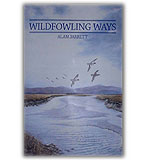
Beautifully illustrated by wildfowler Ian
Phipps, and written by Alan
Jarrett chairman of KWCA and BASC, 'Wildfowling Ways'
is available from Kent Wildfowlers at £17 + P&P.
E-mail wildfowling
ways to reserve
your copy.
New land
purchased at Oare.
The KWCA has just completed
the purchase of seawall and saltings within Oare Creek extending
for 1.4 miles. The land previously formed part of Pheasant
Farm.
The purchase will provide some additional shooting for members,
but crucially it will ensure secure access to adjacent areas
under the Association's control.
New land purchased at Halling.
On 1st October we completed our latest land purchase; 45 acres
at Halling Marshes.
Halling lies on the north bank of the River Medway and consists
of freshmarsh, reclaimed saltmarsh, seawall and saltings.
It has the potential to be an important conservation site
for the club, and will provide additional shooting for our
members.
KWCA at Erridge Park Fair.
KWCA representatives were kept
busy with enquiries on the BASC stand at the recent Erridge
Park country fair. Chairman Alan Jarrett said this was our
first fair using our new display set up and the response was
very good indeed. We will be attending more fairs in the South
East this summer. Please come and say hello.
The Kent Wildfowling and Conservation
Association turn to Sussex for new land purchase.
In a daring departure from its normal
land acquisition programme in Kent the KWCA has purchased
land in East Sussex, and in so doing has reinforced its position
as the premier land-buying club in the country.
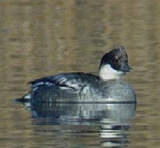
The recent purchase is of Bowley’s Marsh, a 35-acre
site on the Pevensey Levels near Herstmonceux, East Sussex.
The Pevensey
Levels extend to some 4,300 hectares. Bowley’s Marsh
is within the Pevensey Levels SSSI, and is wet grassland managed
in the traditional way.
KWCA Chairman
Alan Jarrett said, “We are delighted to be able to make
our first purchase outside of Kent. We have been looking to
expand our horizons for some while and this site seems an
ideal place for us to start.
We have members
from all over the country, with a good number in Sussex and
West Kent, so it important for us to provide facilities closer
to where our members are. This will also hopefully give us
an opportunity to grow our membership in that part of the
country, and this in turn will allow us to acquire more land
in that area.
Bowley’s
Marsh is an exciting project for us, and the Pevensey Levels
present us with an opportunity to take our particularly innovative
brand of shooting and conservation to sites away from our
North Kent heartland. I expect this to be merely the first
out-of-county purchase by the KWCA.
Wildfowling in the 21st century
The BASC Wildfowling Conference on Friday 10 and Saturday
11 October brings together a formidable pool of expertise.
Key speeches by Russell Bate chairman of Field & Game
in Australia, consultant Alan Bird and BASC chairman Alan
Jarrett.
On Friday there is an evening reception and buffet hosted
by Kent wildfowlers, ticket price £7.50. The conference
fee is £38.00 including lunch and refreshments.
For further information contact Diane McKenzie on 01244 573014.
New land
purchase confirmed
The first of two new land purchases
has been confirmed by KWCA. The Kent wildfowlers have completed
the purchase of the saltmarshes in The Swale known as The
Lillies.
The Lillies
are situated in the western end of The Swale to the north-east
of the mouth of Milton Creek, and are enclosed within our
non-shooting Crown area of Elmley Reach. The area is about
400 yards north west of the land we bought last year at Little
Murston farm.
Whilst it is a
farily small area it is a piece of land we have never had
the shooting rights over before and as such represents more
real growth.
Watch this space for details of the other land purchase KWCA
are undertaking.
Greylag Geese in 800-mile round trip
to Glasgow loch
Once a year, when greylag geese need
to replace their feathers, they fly off on a short migration
to find a watery sanctuary to moult in safety.
Scientists in Gloucestershire were surprised to discover a
population of greylag geese that abandoned their haven in
the Forest of Dean to fly 400 miles north to Glasgow. After
gaining a fresh set of feathers, the geese then flew back
home.
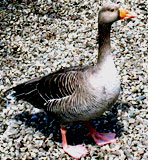
The Wildfowl and Wetlands Trusts (WWT) revealed the results
of their latest ringing survey, which showed the geese making
an 800-mile round trip from their reserve in Slimbridge to
Hogganfield Loch in Glasgow.
The WWT's waterbird monitoring officer, Richard Hearn, said
that the migration was unprecedented.
"We have been monitoring greylag populations for over
50 years and until now had never noted the British geese travelling
large distances to moult," he said.
"So I was astounded when colleagues in Glasgow told me
they had spotted Gloucestershire birds on Hogganfield Loch.
"These birds, ringed on Speech House ponds in the Forest
of Dean last summer, were seen at Slimbridge during the winter,
then in Glasgow in June and July and are now back at Slimbridge
again.
He added: "We have no idea why these birds choose Glasgow
for their moult when there are plenty of safe locations for
them far closer to home."
Although Hogganfield is known as Glasgow's most important
site for migrating waterbirds, its location, at little more
than three miles from the city centre, also makes it a favourite
spot for dogwalkers and picnickers.
A spokeswoman for the WWT explained the reasons behind the
greylags' annual migration. "During the moult to replace
worn-out feathers geese are extremely vulnerable as they are
unable to fly and consequently choose locations where they
are relatively safe from disturbance," she said.
"However, their chosen moult site, Hogganfield Loch,
in the Glasgow suburbs, is heavily used by people, implying
that the birds must benefit in other ways – perhaps
by access to additional food sources and protection from predators."
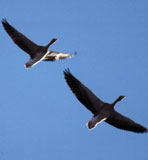
The greylag is the largest of the wild goose species native
to Europe, and is the ancestor of most domestic geese.
Most families of birds undergo a gradual moulting process,
replacing old flight feathers over a long period.
However, wildfowl, such as the greylag, lose all their wing
feathers simultaneously – leaving them flightless and
vulnerable for several weeks.
Mark O'Brien, research biologist with the Royal Society for
the Protection of Birds, said: "We know that moulting
grounds are separate from breeding grounds but this is really
quite bizarre that they go so far and ignore other sites on
the ground.
The Controls on Firearms consultation
Firearms Controls - The Government
has published a Consultation Paper on Firearms Legislation.
Download a PDF of the Consultation
document here - 1.16Mb
download.
If you shoot, you could well find that yet again the Government
is affecting your freedoms by introducing harsh controls on
legitimately held Shotguns and Firearms.
Read the Government's Consultation paper and Write to your
MP or write to your local papers to make the case for legitimate
shooting.
Publication date: 12 May 2004
Closing date: 31 August 2004 (but you can still
write after that date)
Responses can be emailed to: firearmscontrolsconsultation@homeoffice.gsi.gov.uk
Or addressed in writing to:
Firearms Controls Consultation
Home Office
5th Floor
50 Queen Anne's Gate
London SW1H 9AT
Wildfowlers warned - hide your guns
Suffolk wildfowlers have been warned to carry their guns
in weapon cases on public paths alongside the River Orwell
– or face prosecution.
The warning comes after a man walking near Levington Creek
at dusk was frightened when three men in camouflage gear walked
towards him on the footpath carrying 12-bore shotguns.
The hunters were carrying guns openly and startled the walker,
who has asked not to be identified. Police have warned wildfowlers
could be arrested for carrying unconcealed guns – even
when there is no danger to passing pedestrians. Even though
it was quickly apparent the wildfowlers were heading for a
bird shoot, the rambler has demanded hunters conceal their
guns to prevent others being frightened.
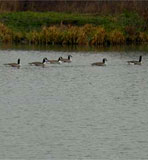
He said: "It gave me quite a fright when I suddenly
looked up and there in the middle of nowhere were three men
carrying guns heading towards me."
"How can it be right that people are allowed to carry
weapons like that on a public footpath where families could
be walking?"
Two clubs have leases for shooting ducks and geese on the
banks of the Orwell during winter with dusk or dawn the most
popular times.
Sgt Mick Richardson, of Felixstowe police, said there had
been no reports of incidents but promised complaints would
be investigated.
He said: "People should not be walking around in a public
place with any form of firearm because they run the risk of
possibly being arrested."
"You can buy gun cases and I would strongly suggest
that it is advisable these days that if you have to move a
gun in a public area to somewhere, even if it is a short walk
to take part in a shoot, to use one."
It is an offence under the Firearms Act to have a loaded
air weapon or any other firearm, whether loaded or not, in
a public place. The act applies to public rights of way and
to permissive paths.
Kevin Butters, chairman of the North Orwell Shooting and
Conservation Club, said wildfowlers were responsible people
who had licences for their guns and had to belong to the club
to shoot on the banks of the river.
He said: "It is getting pretty ridiculous the way people
go on about guns – we have even had the police called
when we have been carrying a gun across a farm field on a
legitimate shoot."
"Wildfowling is a country pursuit. I think people read
too much into these things – they think everyone with
camouflage on is a villain. They see things like Hungerford
on the TV and get the wrong idea."
Background to story:
stamina and patience are hallmarks of a wildfowler, who may
sit camouflaged, dog at his side, on a wet, muddy marsh for
hours – and never fire a shot.
Shooting ducks and geese is a sport which goes back centuries
with its roots in the rural traditions of killing game for
food, living off the land to survive.
Those hunting in our estuaries today are after wild geese
and ducks, mostly migrants, travelling from the Arctic circle
and Scandinavia in autumn and returning to their breeding
grounds in the spring.
Wildfowlers – who have an intimate knowledge of the
wild and dangerous coasts and estuaries – have never
attracted the furore of other country sports, such as hunting
with hounds.
Trimley Marshes nature reserve warden Mick Wright declined
to discuss the rights and wrongs of shooting birds –
but said management of the sport in the area is first class.
The Suffolk Wildlife Trust has excellent relationships with
wildfowlers using the rivers Orwell, Alde and Ore.
Mr Wright said his main concern was to limit the shooting
to avoid disturbance to the birds – either displacing
them away from the rivers, or sending too many into the air
at one time, causing panic and damage among flying birds.
He said: "It is a legitimate sport and my aim is to
work closely with the people involved to make sure that conservation
work is protected."
"There is good liaison with the wildfowl clubs and I
just wish that all groups were as well organised as they are.
"The clubs are the best policeman on the river because
if there are cowboy shooters out there they find them and
then they can be dealt with and stopped. We don't want cowboy
shooters any more than they do.
"They eat the duck they kill and they don't overshoot
because that's not in their interests. In fact, I wouldn't
say that they kill that many birds at all."
Two clubs have leases from Ipswich Borough Council to shoot
on the banks of the Orwell – the River Orwell South Shore
Club and the North Orwell Shooting and Conservation Club.
Kevin Butters, chairman of the North Orwell club, said the
group had about 15 members who did not exploit the birds on
the river and followed all the national association rules
and Wildlife and Countryside Act 1981
Although the season starts in September, members did not
shoot until October until the nights start to draw in and
most members of the public are no longer walking the shores
and footpaths.
Most shooting took place a little after dusk or just before
dawn.
"Wildfowling is a country pursuit and our members are
interested in conservation. We don't kill large numbers of
birds, it's not detrimental to the bird life or wildlife of
these rivers at all," said Mr Butters.
"The reason the club was formed in the first place was
to stop illegal shooting on land adjacent to the river and
ensure it can be effectively controlled. People were coming
from all over the country to shoot before you had to be a
club member."
Dates for 2003 season
| Common Snipe |
Aug 12 - Jan 31 |
| Coot/Moorhen |
Sept 1 - Jan 31 |
| Duck & Goose - below HWM of ordinary spring tides |
Sept 1 - Feb 20 |
| Duck & Goose - inland |
Sept 1 - Jan 31 |
| Golden Plover |
Sept 1 - Jan 31 |
| Woodcock |
Oct 1- Jan 31 |
BASC
reveal new WHT stamp design
The
2003 UK Habitat Conservation Stamp will feature a painting
depicting Barnacle Geese on the Solway Firth by famous wildlife
artist, John Cox.
Every
year the stamp design alternates between a game and wildfowling
design.
The WHT is largely supported by sales of its £5 stamp, which
features the work of a different wildlife artist each year.
Funded by Britain's shooting community, since 1987 the WHT
has offered loans of almost half a million pounds and made
further grants of more than £76 000.
New gas plant to be built at Grain
Swedish construction company, Skanska has
received two contracts worth £80 million from National Grid
Transco to convert a liquid natural gas (LNG) storage terminal
on the Isle of Grain, in the Thames Estuary, into an importation
facility.
The largest contract is for the design,
construction and installation of turnkey facilities to import
LNG from specially adapted ships. This includes the construction
of a new jetty on the River Medway to allow ships to dock
and unload their LNG cargo. In addition, Skanska will construct
a 3.5-kilometer pipeline from the jetty to four large storage
tanks, including the foundations and land corridor for the
pipeline.
The smaller contract is for modifying the
four existing tanks, each with a capacity of 50,000 cubic
meters, for the storage of the LNG. The projects will start
immediately and are scheduled to be completed by the end of
2004.
The existing gas facilities will continue
to operate at full capacity during the construction period.
Skanska's British business unit Skanska UK was awarded these
two contracts after first completing a concept study on the
project last year.
A Skanska UK unit originally built parts
of the Isle of Grain facility in the 1970s.
Scheme enhances habitat for wintering
waders and wildfowl at Ellesmere Port
A £1M scheme to reduce flooding and improve
wildlife habitats in Ellesmere Port has been unveiled. The
project, officially opened by Environment Minister Elliot
Morley, will enhance the River Gowy and Thornton Brook in
Stanlow.
The Environment Agency has been working
with Shell, which owns the land, on the project and has contributed
£100,000 towards the cost of a flood-defence scheme. The agency
is also working with Cheshire Wildlife Trust, which will manage
a new wetland nature reserve at nearby Gowy Meadows, featuring
rare insects, birds and plants. Carefully positioned sluices
will allow the trust to manage water levels over an area equivalent
to more than 270 football pitches.
In the past both the River Gowy and Thornton
Brook have flooded, the flood-defence work involved changing
the course of Thornton Brook through Gowy Meadows. The design
provided an opportunity to develop the new nature reserve.
As well as diverting the brook, flood defences have been improved
by raising existing flood banks and repairing tidal gates.
During heavy storms, floodwater from the
rivers will continue to be held back in Gowy Meadows. The
aim is to create large areas of seasonally wet grassland to
attract breeding and wintering waders and wildfowl, and water
voles.
Poor
man's asparagus
Picking
samphire is hard work, but Norfolk wildfowler Mick Castleton
makes his living through daily visits to the marshy margins
of the Wash to pick the popular delicacy samphire. It's a
30-minute walk on and a 30-minute walk back. As the grass
gets out into the Wash, so the samphire moves out with it.
The grass is moving out very fast, and that's why we have
the walk.
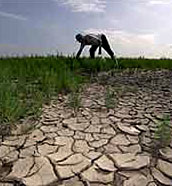
Between
June and the end of August, the edges of the giant estuary
are fringed in a brilliant green, as the succulent stems push
their way up through the mud. Samphire (salicornia) has a
high salt content and is also known as glasswort, a name derived
from its ancient use in the glass industry.
Also
valued in the past as a preventive against scurvy, it has
traditionally been either pickled or eaten fresh, simmered
for about 10 minutes and served with a simple sprinkling of
black pepper and vinegar. Since being elevated to culinary
star status by the likes of chefs Rick Stein and Jamie Oliver,
however, it has been given more exotic treatment. Serverd
with Olive oil, cooked in the oven is the new trend – or with
butter. A lot of local people eat it raw in a salad and don't
even bother to cook it."
He
has been enjoying samphire since he was a boy, when he accompanied
his father on trips to the marshes. Born into the old King's
Lynn fishing community of North End, Mick and his wife Tina
also run a shellfish business and have been picking samphire
commercially for nearly 20 years.
Their
customers have included the Prince of Wales, who ordered 40lb
for a party and had it collected from the couple's North Lynn
home by a driver in a Daimler. And while you'll pay around
£1.50-£2 a pound for samphire at local markets, prices can
rocket as high as £7 in London. Back in the real world at
Wootton Marshes, it is – quite literally – a case of getting
stuck in, as Mick, Tina and their helpers gather 600-700lb
of the stuff a week.
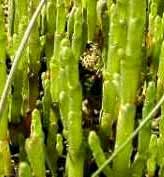
Mick
is one of only two locals officially allowed to harvest it.
"Because you lived in North End and you're a fisherman, you're
allowed legally to make a living off the Wash," he says. "That's
an ancient right for the fishermen of King's Lynn and around.
They're allowed to pick samphire for their livelihood. It's
one of those charter things. "It's one of the best years we've
ever known for samphire. We had all that rain when the tides
weren't on the marsh and we had some nice warm days afterwards.
"It depends on the weather conditions completely and this
year's been perfect. If you get a lot of dry summers you can't
pull it out of the ground.
Photography
competition - freshwater sites
The
Environment Agency is urging people to photograph local freshwater
sites inj Anglia, to support a United Nations-backed initiative.
The images, which will be collected nationally, will form
part of an online archive that will be available from September.
"This national collection will demonstrate the importance
of these sites to people and wildlife – and the need to protect
them – so we want to make sure our region is well represented,"
said Joanne Hayward, the agency's corporate affairs manager.
It is being organised as part of H2O03, the UK initiative
to celebrate the UN International Year of Freshwater.
Prizes
are on offer for the best photographs, including holidays
at Center Parcs, trips to Wildfowl and Wetlands Trust centres
and hundreds of pounds worth of photographic equipment.
There
will also be a national writing competition on the theme Water
for all – who cares? People can also take part in an art competition
on the theme of freshwater. Details of how to get involved
can be found on the H2O03 website: www.H2O03.org.uk
KWCA join
4 Million people in opposing Airport Plans
KWCA have joined forces with other groups
totalling 4 million members, including the RSPB, to oppose
the airport expansion plans at Cliffe marshes which threaten
our wildfowling interests throughout the area.
The groups have united to fight airport
expansion and believe that there is no case for an airport
at Cliffe and that potential demand for air travel is grossly
overestimated.
Read
more.
Calls for cull of duck population
causes Ruddy Row!
A leading naturalist has accused some conservationists
of "ecological fascism" for trying to eradicate foreign plants
and animals. Richard Mabey, who lives at Roydon, near Diss,
claims attempts to kill off a range of species, including
the ruddy duck which comes from North America, are akin to
attempts by the Nazis to "purify" Germany.

His views, in his regular column for BBC
Wildlife Magazine, have upset naturalists, who say they
are simply trying to help a variety of species, often small
and weak, to survive. Bitter rows have broken out in recent
years over plans to eradicate or "control" species seen as
a threat to native plants or animals.
The controversial suggestion, backed by
the RSPB,
is to cull the entire UK ruddy duck population in order to
help protect the rare Spanish white-headed duck.
Another is a campaign to eradicate hedgehogs
from a Hebridean island – to which they had been introduced
– after the creatures were blamed for eating the eggs of rare
breeding birds.
Mr Mabey said he was appalled by national
eradication programmes because they conflicted with the evolution
of change in nature. "Nature hasn't the slightest respect
for species and racial barriers," he said. "I am totally against
the principle that if something has been introduced into this
country from abroad it is dangerous and not in keeping."
Julian Roughton, director of the Suffolk
Wildlife Trust, said the majority of species introduced
to the UK were welcome additions, but some had caused problems
and had to be controlled to prevent them driving native species
to extinction.
Chris Durdin, RSPB spokesman in East Anglia,
said: "After habitat destruction, the introduction of non-native
species is the main reason for the extinction of native species."
Membership renewals
Renewal notices have now been sent out. If you have not yet
renewed your membership and wish to do so - please contact
Bob Stead Tel. 01322 554518 or e-mail membership
straight away.
If you have any friends who wish
to join KWCA, you can take advantage of the membership recruitment
scheme whereby existing members who introduce a FULL (NEW)
member will be eligible for a rebate on their next year’s
subscription.
KWCA Social evening 17th July 2003
Alan Jarrett chairman of BASC
and KWCA will give a talk about wildfowling throughout the
UK. All welcome. Buffet will be served. 8.00pm start.

Members and non members are ALL welcome.
Non members call 07836 771715 (voicemail) for details.
'DEMOCRACY GOING TO THE DOGS' PROTEST
PARLIAMENT SQUARE
Wednesday, 9th July To mark the Third Reading of the 'hunting
with dogs' Bill - this is a call to arms for all who support
fairness, freedom and tolerance in this country. Everyone
within 150 miles of London is urged to make the greatest effort
to come - those further away please save your fire power for
another time, especially if you have local events to attend.
TIMING * 5.00 pm - 7.00 PM for dogs and owners.
The vote will be at 10.00 PM
For further information please contact the Countryside Alliance
Action Office on 01367 850 488
or email grassroute@countryside-alliance.org
see CA website for more details www.countryside-alliance.org
Read what the BASC are saying about the bill here.
KWCA Dinner Dance
Sir Johnny Scott of 'Clarissa
& the countryman' fame was the guest speaker at the
KWCA 50th anniversary dinner dance, held earlier this year
at the Ramada Jarvis Hotel, Maidstone.
The evening included dancing to the Peter Elligate Showband.

Johhny and Clarissa were available throughout the evening
to sign copies of their books:
Clarissa and the Countryman by Clarissa Dickson Wright &
Johnny Scott Published by Hodder Headline, 2000 ISBN 0747232474
Price £20.00
Clarissa and the Countryman Sally Forth by Clarissa Dickson
Wright & Johnny Scott Published by Hodder Headline, 2001 ISBN 075531011X
Price £20.00
New research into the effects of lead
shot on the environment
Wildfowlers are already familiar with the rules that came
into force in England & Wales in 1999 following a voluntary
lead ban in 1995, requiring the use of non-toxic shot for
all waterfowl shooting. KWCA require the use of non toxic
shot on all of its shooting grounds.
The impetus for this legislation had its origins in the 1970s
when reports of dead waterfowl were linked to poisoning by
lead pellets ingested as grit.
Although there has been continuing debate over the effectiveness
and cost of alternatives, the ban on lead for duck shooting
has been mostly accepted as necessary.
(see the conservation section for details of alternatives
to lead shot)
New research now suggests that lead from spent shot may be
a wider environmental problem. Two studies have caused particular
concern:
Firstly, a sample of duck livers from Spain showed them
to have high lead levels (following lead shot ingestion)
and that food cooked from these had lead levels that exceeded
EU safety standards.
Secondly, a study of American woodcock in Canada showed
that they too had high lead concentrations, not from ingested
lead shot this time, but from eating worms which had been
contaminated with soluble lead from the breakdown of lead
shot in the soil.
These concerns were taken up by the EU
Scientific Committee on Toxicity, Eco-toxicity and the Environment
which, in February, noted that lead shot remains the most
important contributor of lead to the soil.
The Committee recommended a thorough review of the literature
and current data sources. In the long-term lead will probably
have to be phased out in all shot.
Clarissa and the Countryman come
to Cliffe
Clarissa Dickson-Wright and Sir Johnny Scott visit the Kent
Wildfowling and
Conservation Associations Cooling reserve.
Reserve manager Phil Elliott and other KWCA members discussed
the flora and fauna on the proposed site of the countries
largest international airport in their regular BBC2 slot.
|
|
Previous
- Next
Review: Clarissa Dickson Wright
and Johnny Scott visit the North Kent marshes, a remarkable
and little known landscape just thirty miles east of
London. Its remoteness has made it a gathering point
of wildfowl for centuries. The area is also steeped
in history, from Charles Dickens to the magnificent
Cobham Hall, and Shades House, a pub frequented by smugglers.
Farmers and wildfowlers talk of their fear that all
might be lost as it is one of the proposed sites for
London's new airport.
Country Members
The KWCA AGM last year approved a new Country Member
category.
This is available for those living OUTSIDE our catchment
area of Kent, London,
Surrey, East Sussex and Essex, and is limited to 6 day
permits.
If you wish to take advantage of this offer, contact
KWCA Membership Secretary.
Tel. 07836 771715 or e-mail membership
for details.
KWCA clothing
New for 2002 - we have a range
of KWCA clothing - embroidered with the club logo.
Polo shirts £15.00
Hooded sweatshirts £22.50
Fleeces £30.00
Caps £7.00
Tel. 07836 771715 or e-mail
club
secretary to order.
|
|
